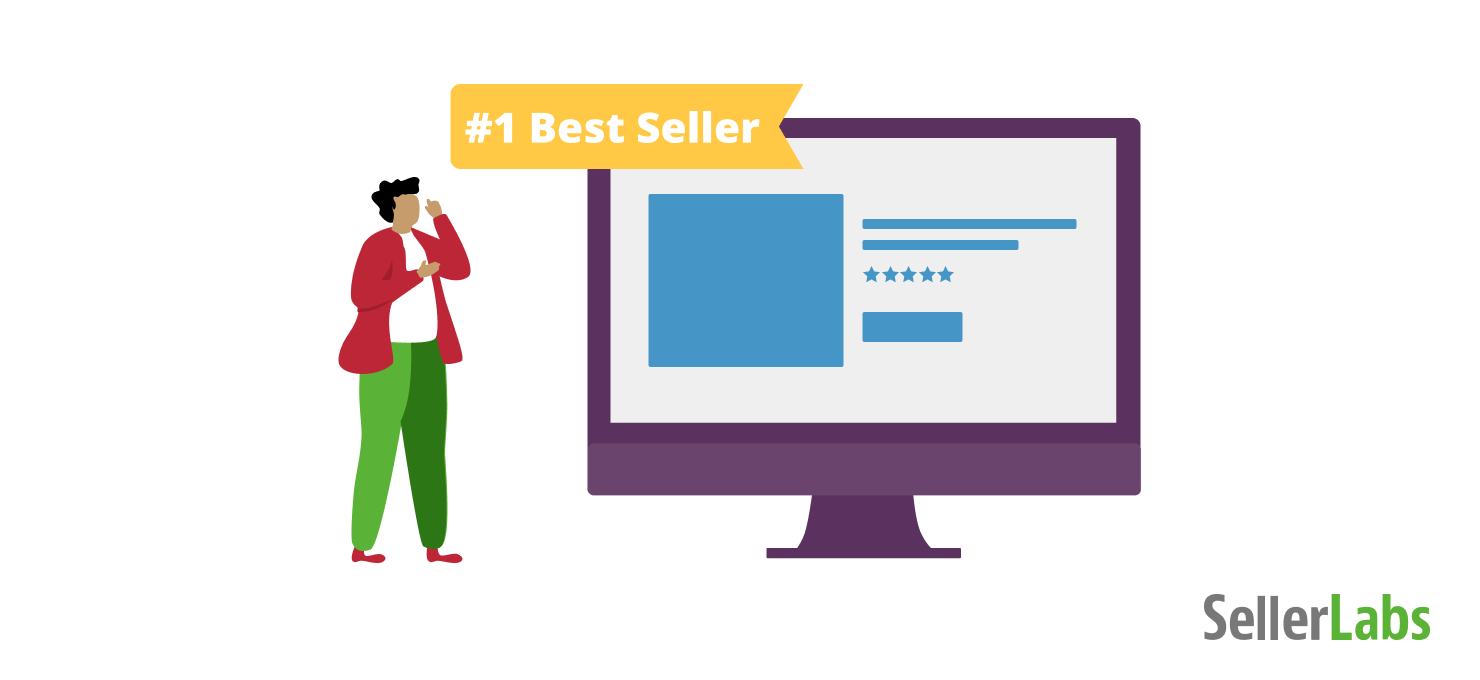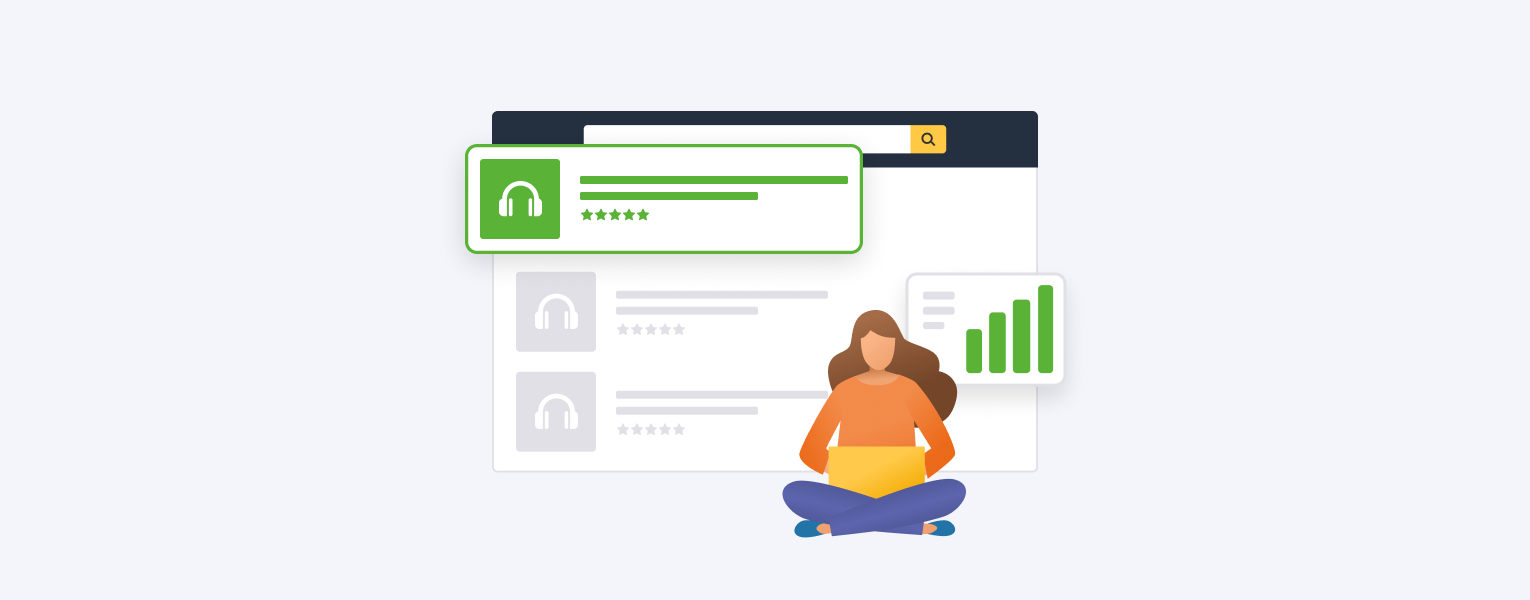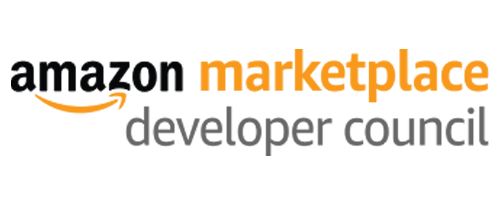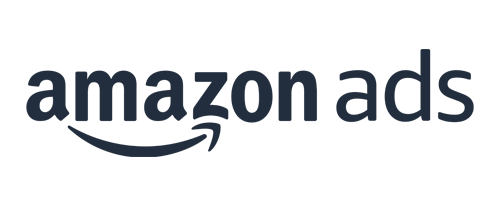Superlatives just feel good. The best seller, the most popular, the newest model — whatever it is you’re “best at”, rest in the sweet satisfaction of knowing that you’ve made it to the top.
The Amazon Best Seller Badge, that orange ribbon-like icon in the top left of a product’s picture, not only makes you feel good, but it also helps you sell better. Shoppers love it and Amazon will reward you with better rankings when you’ve got it.

Oooooh. It’s so shiny. Want to see it in action?
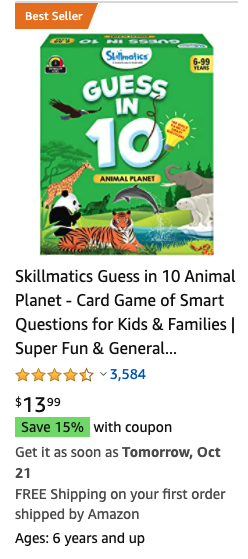
Wow, that’s nice. Now let’s work on getting you that coveted “best” label.
In order to become the top seller, you need to understand what the Amazon Best Seller is, and what I call the Amazon Best Seller Badge 3Cs:
What is the Amazon Best Seller Badge?
The way to get an Amazon Best Seller badge is by selling the most products within your category over time.
The Amazon Best Seller badge is precisely that: an icon displayed in the search results and on the product detail pages for items that are the best sellers in a category. Originally, Amazon displayed the badge only for the #1 best seller in a category, but now several products in a single category can carry the badge simultaneously.
In general, there are 100 best sellers in any category. The broader a category (e.g., a category such as “Pet Supplies”), the more competition is in the 100 bestsellers. The more specific the sub-category (e.g., “Knots, Macrame & Rope Work Craft Books), the less diversity and competition.
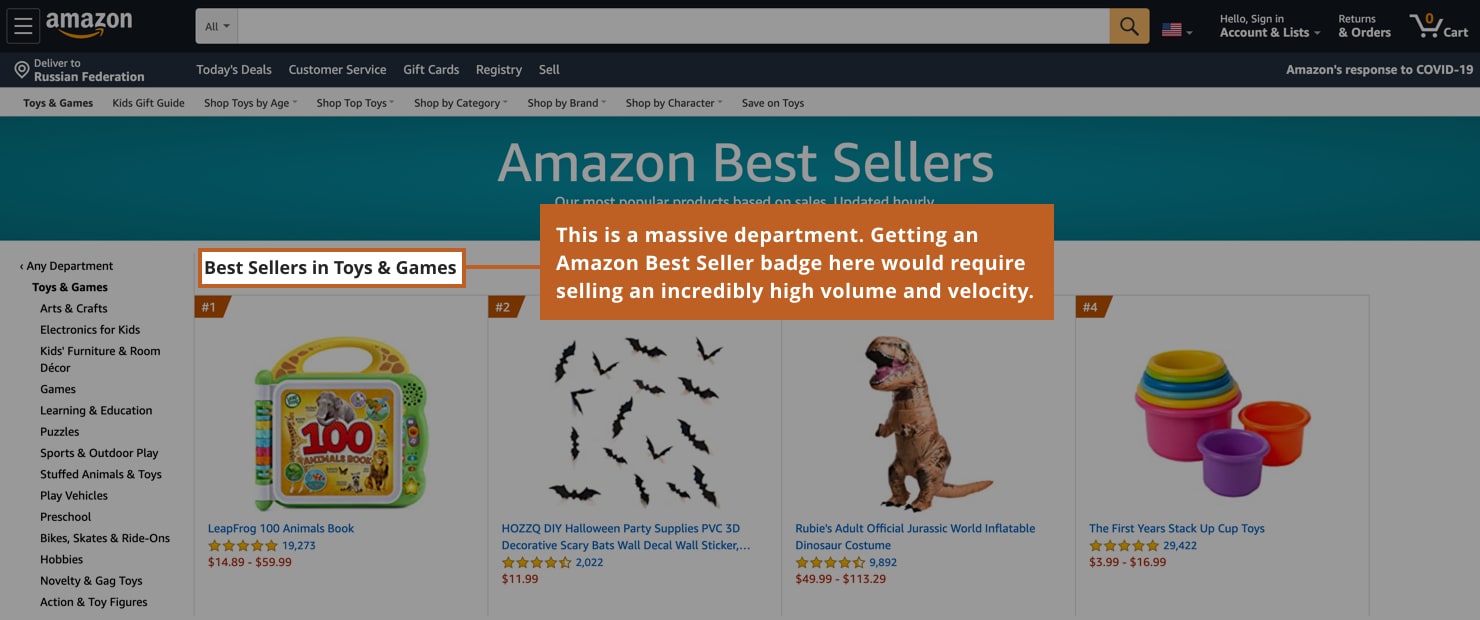
In some sub-categories, there may not even be 100 bestsellers because the category is so slender. Needless to say, getting your product to be a best seller in “Toys and Games” is a different endeavor (and achievement) than getting your product to be a best seller in “Traditional British & Celtic Digital Folk Songs.” However, being amongst the top sellers in either category will get you the same Amazon Best Seller badge.
CHAPTER II A Closer Look at Amazon Best Seller Badge
By Amazon’s own definition, the best seller badge seems pretty straight forward. Unlike most Amazon explanations, the definition of Amazon Best Sellers is clear. However, like most things on Amazon, even the clearest explanation can have multiple implications.
Our most popular products based on sales. Updated hourly.
Notice that bestsellers are updated hourly (sometimes there’s a lag of an hour or two), which means that the badge is up for grabs 24 times a day. It also means that if you have the badge for one hour, you can lose it the next hour. When a product loses best-seller status, be it after one hour or one month, the Amazon Best Seller badge is gone unless the product regains the spot.
- Ranking #1 means that a product has recently sold more than all other products in that category (or subcategory) within that particular marketplace. That is to say, a book that ranks #1 on Amazon.co.uk but ranks #139 on Amazon.com will not carry the badge on the United States marketplace.
- Not all categories display the badge at all times. If there’s not enough sales or data about sales, there will be no badge displayed in that category for that hour.
- Amazon Best Sellers has become a category of its own with prominent placement in the top navigation. This makes getting into the top seller club even more valuable. Shoppers who browse for items, rather than search for specific ones can find gift ideas, see bestsellers, and buy items that they wouldn’t have known about otherwise.
CHAPTER III The Amazon Best Seller Badge 3Cs: Competition, Calculation, and Category
By now, all sellers know that they are likely to sell more — and to sell more at a faster pace — by being 1P wholesale vendors who sell large quantities directly to Amazon. With vendors, Amazon is able to sell to consumers at low prices. You can also sell tons as a 3P brand-registered seller if you use FBA.
Basically, Amazon rewards sellers when they do all of the things that make business on Amazon easier and more profitable. You can read all about how to turn the gears of the Amazon flywheel, in our updated guide, How to Sell on Amazon. In a nutshell, you scratch Amazon’s back, they scratch yours.
If you are a 1P wholesale vendor or a 3P brand-registered seller with FBA, that you are in good shape. Now, you’ve got to consider the three Cs of being a top-notch seller: Competition, Calculation, and Category.
C1: Competition
TL;DR: You can’t beat Amazon at their own game.
If your numbers (prices, account health, shipping speed, ratings, etc.) are in good shape and your Amazon listings are optimized, you are well-positioned to compete. Lower prices and “Sold by Amazon” or “Fulfilled by Amazon” are all green lights and confidence boosters for buyers, and all increase your chances of winning the Buy Box as well as ranking higher in search results.
But remember: there is one seller with whom you cannot really compete and win: Amazon itself.
If Amazon has a private label offering, that product will naturally be “Amazon’s Choice” in the category. It will also likely be low priced and it will certainly be fulfilled by Amazon.
Amazon’s Choice + low prices + FBA = Amazon Best Seller Badge.
You can’t win in a category where Amazon’s products have the trifecta of low prices, FBA, and Amazon’s choice.
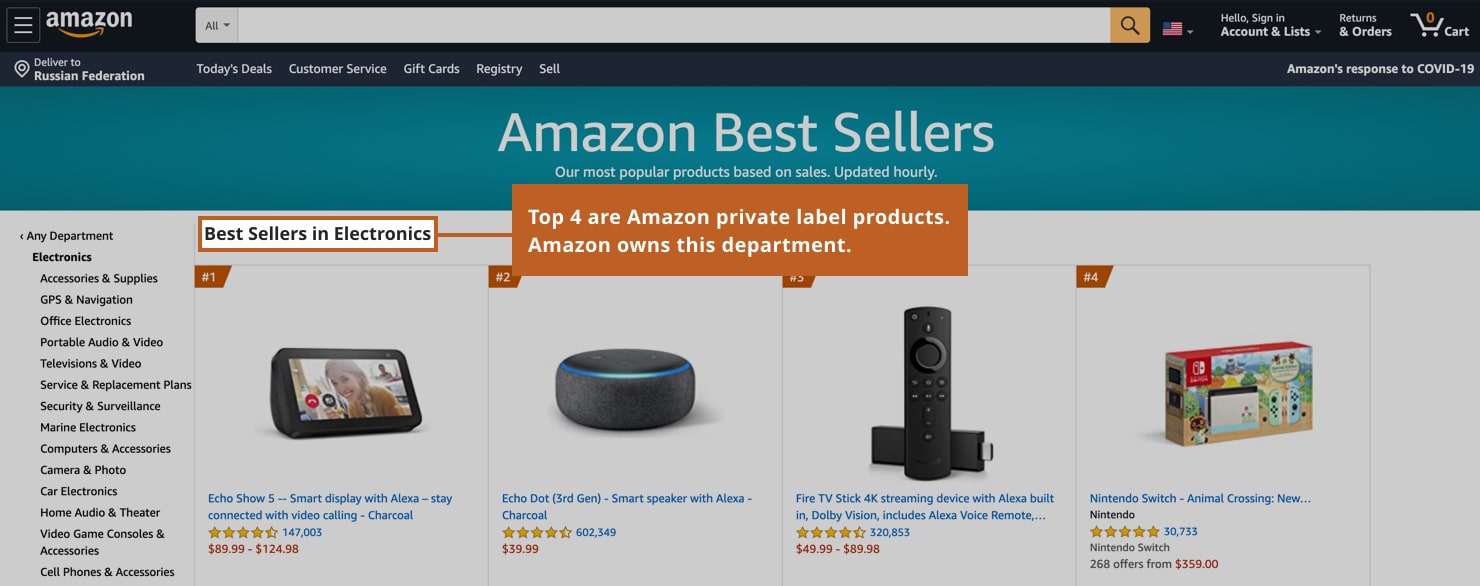
If Amazon doesn’t own the category (like they do with many categories), competing hard can win good rankings and even (gasp) the best seller badge.
If you do win the badge, congratulations! Do take notice (and perhaps a screenshot) because the best-sellers are updated hourly. Once another product sells better than yours, the badge goes away and another product in the category beats yours.
In short, yes, you can have a best seller badge for an hour and then lose it — all without even knowing that it happened. And once the badge is gone, it’s gone. Unless your product reclaims the position from square one. Sadly, there is no badge for “Once was a Best Seller”.
So there’s getting it and there’s keeping it, which, much like the getting and keeping the Buy Box, are entirely different things.
C2: Calculation
TL;DR: Amazon Best Seller Badge = Amazon’s Choice + low prices + FBA
Amazon’s criteria for determining a best seller is based on sales, but what does that really mean?
- Amazon is really good at prediction and it is getting better all the time. Calculating a best seller is based on historical sales (the length of that history is not specified) but it also takes into account predictive elements.
- Amazon is really smart at analyzing the sales-period durations. They are neither fully historical (all sales since start) nor are they so brief as to be based on the hour. If they were only based on sales in that hour, there would be unrealistic spikes in product launches where the item is inexpensive and new.
- The Amazon Best Seller badge is awarded according to sales and only to sales. Amazon Best Sellers are precisely that: the items that sell the most in a category. What will not directly push you toward the top spot are product reviews and seller feedback. Of course, product reviews are indirectly correlated to sales; without good product reviews (or worse, with bad ones or none at all), your sales will suffer.
- This is Amazon. As a seller, you can do things to increase volume and accelerate velocity (running a huge sale or promotion, aggressively running Amazon Sponsored Advertising, etc.), but you’re not going to trick Amazon’s algorithm. Give up number-crunching because it is not ethical or sustainable, nor without repercussions. Be cool and play the game as Amazon intends.
C3: Category
TL;DR: Not all categories are created equal.
There’s definitely more prestige, placement, and sales power in having the best seller in “Books” versus having the best seller in “Industrial & Scientific Lab Autoradiography Supplies.” Clearly, there is more competition for “Book” than “Industrial & Scientific Lab Autoradiography Supplies.”
It is infinitely easier to achieve best-seller status in a small-niche super-specific subcategory such as “Cat Leashes” than it is to achieve such in a larger subcategory of “Cat Collars, Harnesses & Leashes” or the even-larger category “Cats” or the much-larger (and infinitely more competitive) category of “Pet Supplies.”
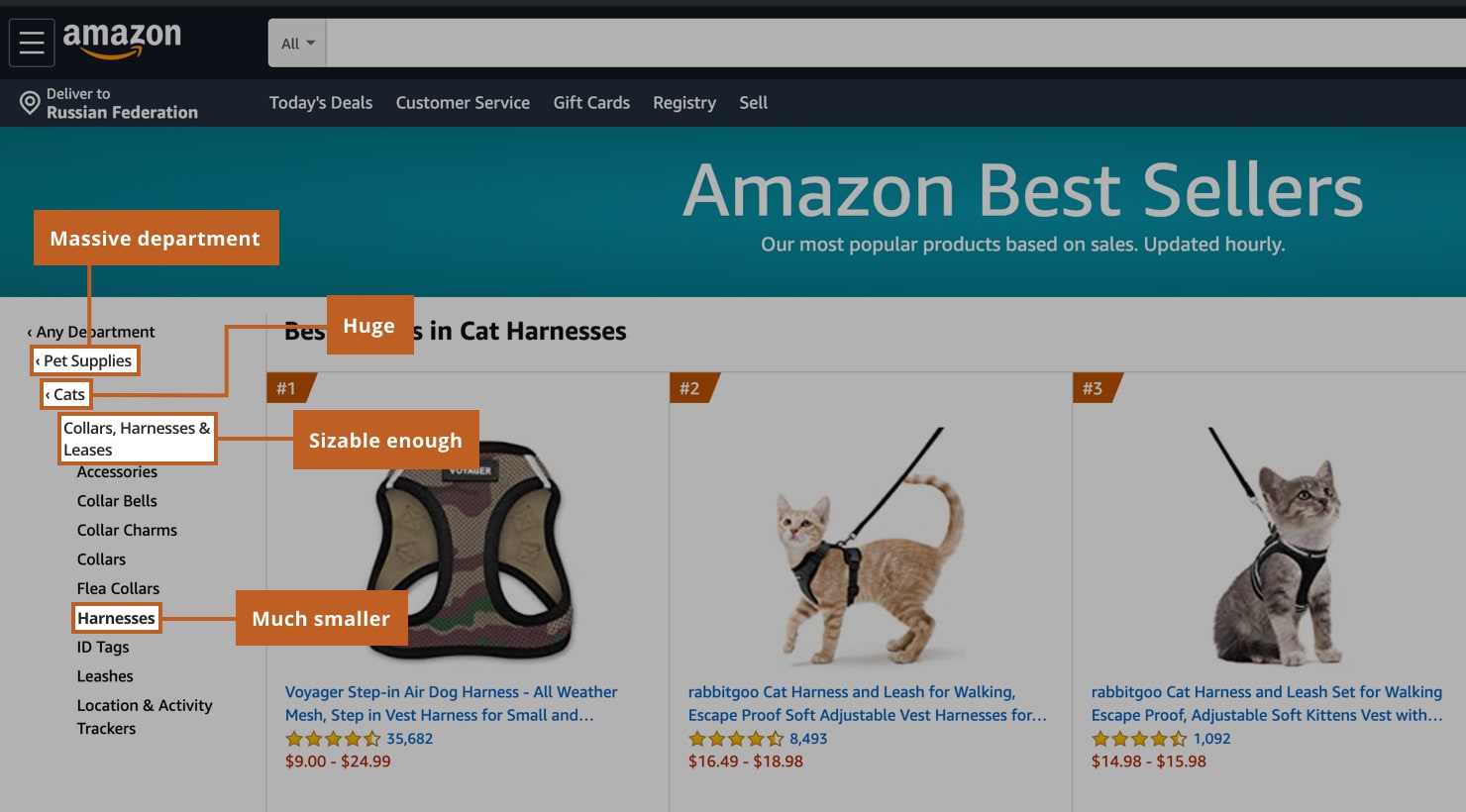
So in this case (as in all product listings), if you are the purveyor of a cat leash and you are pursuing that best-seller spot, you would definitely want to list your product in “Cat Leashes.” “Cat Leashes” is the most-targeted category because shoppers looking for cat leashes who ended up here would be more likely to convert than other shoppers. “Cat Leashes” is also the least-populated category.
You would also want to list in more-general categories so that your product might be found more easily by someone browsing at a higher level of the category tree (rather, the CAT-egory tree).
Since most shoppers do not browse by category but instead search by inputting keywords, it behooves sellers to get granular with their categories. If you want to achieve best-seller status, but not necessarily if you wish to be found by browsers, then get as specific as possible. But as with everything on Amazon, it’s a delicate balancing act.
A Note on Categories and Best Sellers
TL;DR Don’t list a product in a vaguely connected category.
Knowing how Amazon categories work will tempt you to pursue best-seller status by listing in a vaguely connected small category.
For example, COVID-19 created stunning demand for face masks of all sorts. The seller of the product shown below has listed a face mask in the category of “Tools & Home Improvement.” While one might wear a face mask while sawing new boards for a DIY deck project, it’s a stretch to say that the product is a right fit in the “Tools & Home Improvement” category.
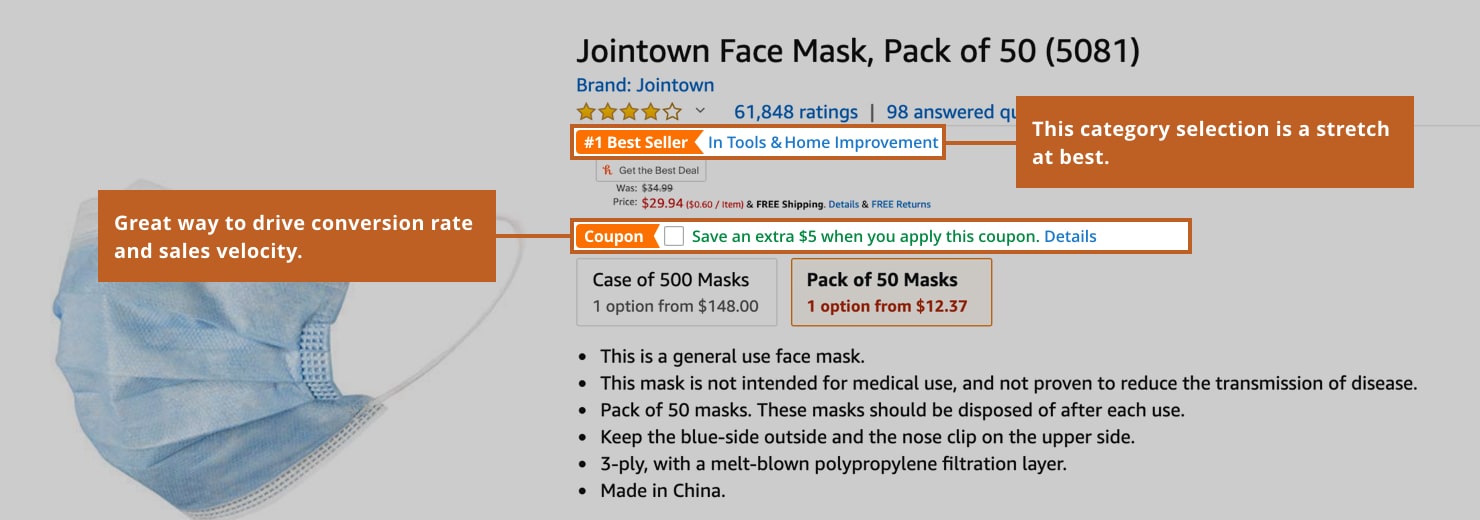
However, the seller put it there and got the top spot and the badge in that category — but not by selling to browsers of that category, rather by selling a relatively inexpensive pandemic-related necessity in a category where there are expensive power tools. The item would be a truer fit in “Medical Supplies & Equipment,” but it faces much more competition there.
And the strategy worked, for a moment. But category stretching is not a solid tactic for the following reasons.
- It’s misleading and it’s not in the spirit of fair play. Consider a shopper who is legitimately browsing for a heavy-duty table saw and gets the first result … a face mask. The shopping experience becomes frustrating when the customer encounters top-level products that simply are not relevant. Don’t be that seller.
- A frustrated shopper leaving a product detail page after not buying can actually be a strike against a product. If users frequently leave your Amazon detail page without making a purchase, Amazon notices that and considers it a high exit rate, a negative when it comes to ranking. Amazon also measures time on the page and picks up on incredibly short durations such as what might occur if a user is steered to a detail page that is not at all a match to the query. So those are red flags to Amazon. No conversion for you; no conversion for Amazon; Amazon counts that against your product.
- Trying to game the Amazon system eventually catches up with you. If you are consistently taking liberties in order to stuff your products into lower-competition categories, Amazon will eventually find out. Getting best-seller status or even the Amazon Best Seller badge is not worth risking your ranking or selling privileges. If you find yourself tempted to manipulate the categories, ask yourself “Is having the badge for an hour worth the risk?”
CHAPTER IV Is the Amazon Best Seller Badge Worth Pursuing?
There is no doubt that the Amazon Best Seller badge has visual appeal and carries weight with customers. Now that it appears in search results as well as on detail pages, it is an even more coveted pledge. However, the badge can last for just a single hour, so the Amazon Best Seller badge may appeal more to seller ego than it does to buyers.
Don’t be distracted by shiny objects. You’re not a raccoon, you’re an Amazon seller trying to run a successful business. Work on doing the things that make your product a legitimate sustainable top-ranking best seller in its legitimate category. Don’t sweat getting the badge or holding onto it. That will happen when you really are #1.
- Focus on keywords and listing optimization and ranking in search results.
- Focus on advertising and conversion.
- Focus on shoppers who know what they are looking for and who choose your product because it best meets their needs and wants
- Focus on customer service and communication.
Keep your eyes on the real prizes: sales, ranking, rating, brand recognition, and customer satisfaction and loyalty. If the badge follows, all the better, but it’s not what really matters.
Looking to Boost Conversions, Accelerate Sales Velocity, and Get Products Ranking Higher on Amazon?
Get all the tools you need to do just that in one integrated app. Start your FREE 30-day trial of Seller Labs PRO.
[css elements/spw]
[modal id=”whitepaper” class=”sl-popup–whitepaper” func=”testFunc”]
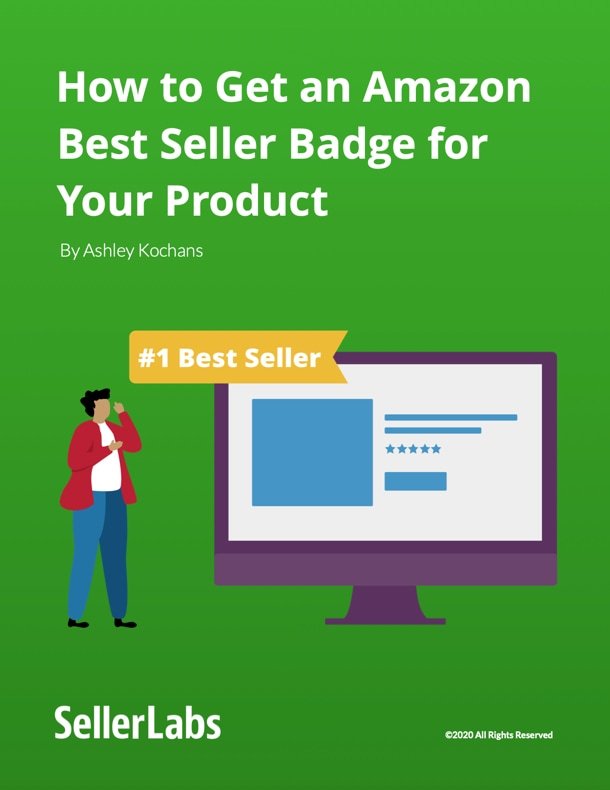
Would you like us to deliver this straight into your inbox for further reference?
[/modal]

